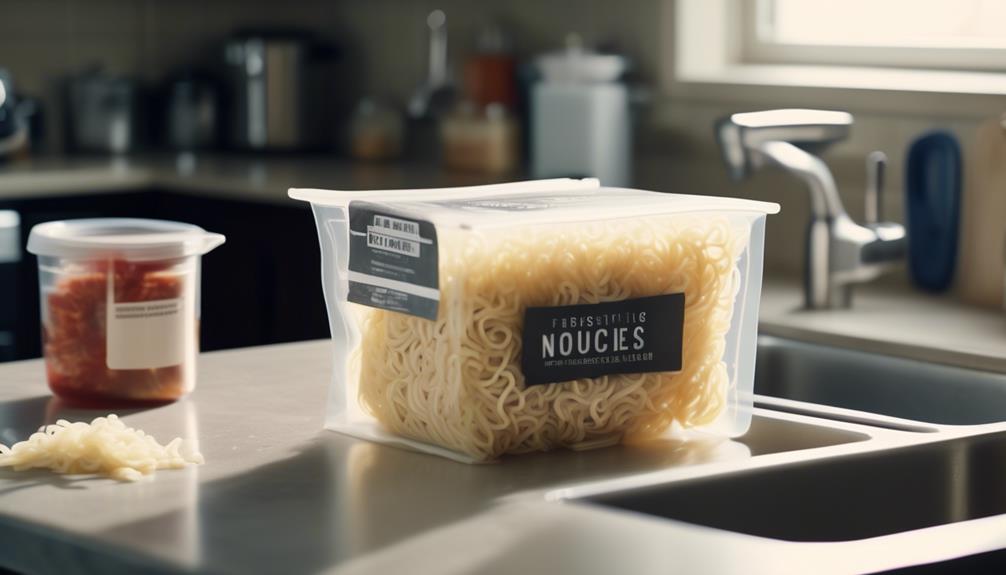In the days of Roman banquets, freezing noodles wasn't on the menu, but in today's modern world, it's a convenient trick you should have up your sleeve. You'll find that freezing noodles can be a simple way to make your meal prep more efficient, especially when you've cooked a batch too large to consume at once.
Start by cooking your noodles al dente; they'll fare better in the freezing process and maintain a better texture when reheated. Make sure to toss them with a touch of oil to prevent sticking, and let them cool completely to avoid ice crystals forming. When you package them, use airtight containers or freezer bags, expelling as much air as possible to ward off freezer burn.
But how do you ensure your noodles don't turn into a mushy disappointment when it's time to bring them back to life at your next dinner? Stay tuned, as we're about to unravel the secrets to perfectly preserving your pasta, ensuring you can enjoy quick, convenient, and tasty meals whenever the craving strikes.
Key Takeaways
- Choose thick, hearty noodles like udon or soba for freezing to maintain their texture.
- Cook noodles al dente to prevent them from becoming overcooked when reheated.
- Cool noodles quickly after cooking to preserve their quality in the freezer.
- Use vacuum sealing or airtight containers to best preserve frozen noodles for long-term storage.
Selecting the Right Noodles
When freezing noodles, it's essential to choose varieties that retain their texture and flavor after thawing. You're looking for noodles that can stand up to the cold without turning into a mushy disappointment. So, let's talk noodle varieties and texture considerations.
Thick, hearty noodles like udon or soba are your best bet. They've a robust structure that doesn't break down easily. These types of noodles freeze well and come out almost as good as fresh when you reheat them.
On the other hand, delicate pasta like angel hair or thin rice noodles mightn't fare as well. They can become too soft and lose their appetizing bite.
When you've settled on your noodle of choice, cook them al dente. This means they should be slightly underdone since they'll continue to soften during the thawing and reheating process. It's a little trick to ensure you don't end up with overcooked noodles.
Preparing Noodles for Freezing
To ensure your noodles maintain their quality in the freezer, start by cooling them quickly after cooking. This stops the cooking process and preserves the texture. Begin by draining your noodles thoroughly – you don't want any excess water creating ice crystals during freezing, which can lead to soggy noodles when reheated.
Here's a practical guide to help you nail the freezing process:
- Noodle Blanching
- Cook noodles al dente, slightly firmer than usual.
- Plunge them into ice water to halt the cooking.
- Drain well to remove excess moisture.
- Portion Sizing
- Estimate servings based on meal planning.
- Use resealable bags or containers for separate portions.
- Flatten bags to save space and ensure even freezing.
- Preventing Clumps
- Toss noodles with a bit of oil or butter.
- Spread them out on a baking sheet to freeze individually.
- Once frozen, transfer them to your desired storage.
Packaging and Storage Techniques
Proper packaging is crucial for maintaining the freshness and texture of your frozen noodles, so let's dive into the most effective techniques. You'll want to start with vacuum sealing, if possible. Vacuum sealing removes air, preventing ice crystals and freezer burn. It's the best way to keep your noodles tasting as fresh as the day you made them. If you don't have a vacuum sealer, don't worry—there are other great container choices.
For temporary storage, you can use resealable plastic bags. Just be sure to squeeze out as much air as you can before sealing them. For longer storage, airtight plastic containers or heavy-duty aluminum foil are excellent choices. Remember to leave a little space at the top of containers as noodles may expand when frozen.
Here's a quick guide to help you choose the right packaging:
| Packaging Type | Pros | Cons |
|---|---|---|
| Vacuum Sealed Bags | Best for long-term storage, Prevents freezer burn | Requires special equipment |
| Resealable Plastic Bags | Economical, Easily available | Less protection, risk of air pockets |
| Airtight Containers | Reusable, Sturdy | Bulky, Takes more freezer space |
Keep your noodles in a place where they won't be crushed by other items, and label the package with the date, so you'll know how long they've been frozen. With the right packaging and storage techniques, you'll enjoy delicious, fresh noodles every time you defrost them.
Thawing and Reheating Tips
Ensure you thaw your frozen noodles correctly to maintain their optimal texture and flavor during the reheating process. To safeguard noodle integrity, avoid rushing the thawing by skipping straight to high heat methods that can turn your noodles to mush.
- Thawing Techniques:
- *Refrigerator Thawing*: Transfer your noodles from the freezer to the fridge several hours before you plan to eat them, allowing them to defrost slowly and evenly.
- *Countertop Thawing*: If you're short on time, you can let the noodles sit on the counter at room temperature for a short period, but don't leave them out too long to prevent bacterial growth.
- *Cold Water Bath*: For quicker thawing, place the noodles in a sealed plastic bag and submerge them in cold water, changing the water every 30 minutes.
When it's time to reheat, gentle methods work best. If you're using microwave methods, ensure you're doing so properly:
- Reheating Tips:
- *Microwaving*: Use the defrost setting or lower power levels to gradually warm the noodles without overcooking them. Stirring occasionally promotes even heating.
- *Stovetop*: Reheat noodles in a skillet over medium heat, adding a splash of water or sauce to prevent drying out.
- *Steaming*: For stickier noodles like rice noodles, steaming them can revive their texture without making them soggy.
Common Freezing Mistakes to Avoid
While carefully thawing and reheating your noodles is crucial for a delicious outcome, it's equally important to avoid certain pitfalls during the initial freezing process to preserve their quality. Freezing noodles improperly can lead to a compromised noodle texture and dreaded freezer burn. Here's what you should steer clear of:
| Mistake | Consequence |
|---|---|
| Not cooling noodles before freezing | Leads to steam and ice crystals |
| Freezing noodles in large clumps | Causes uneven freezing and poor texture |
| Using non-airtight containers or bags | Exposes noodles to air, risking freezer burn |
| Forgetting to label and date the packages | Makes it hard to track freshness and avoid waste |
| Freezing sauced noodles for too long | Sauces may separate and degrade texture |
Don't rush the cooling process after cooking. Spread your noodles out on a baking sheet to cool quickly and evenly. When you pack them for the freezer, avoid overfilling containers or bags; leave some space for the noodles to expand. And most importantly, press out as much air as possible before sealing to protect against freezer burn. Remember, taking a bit more time to freeze your noodles properly will ensure they're just as tasty when you reheat them.

